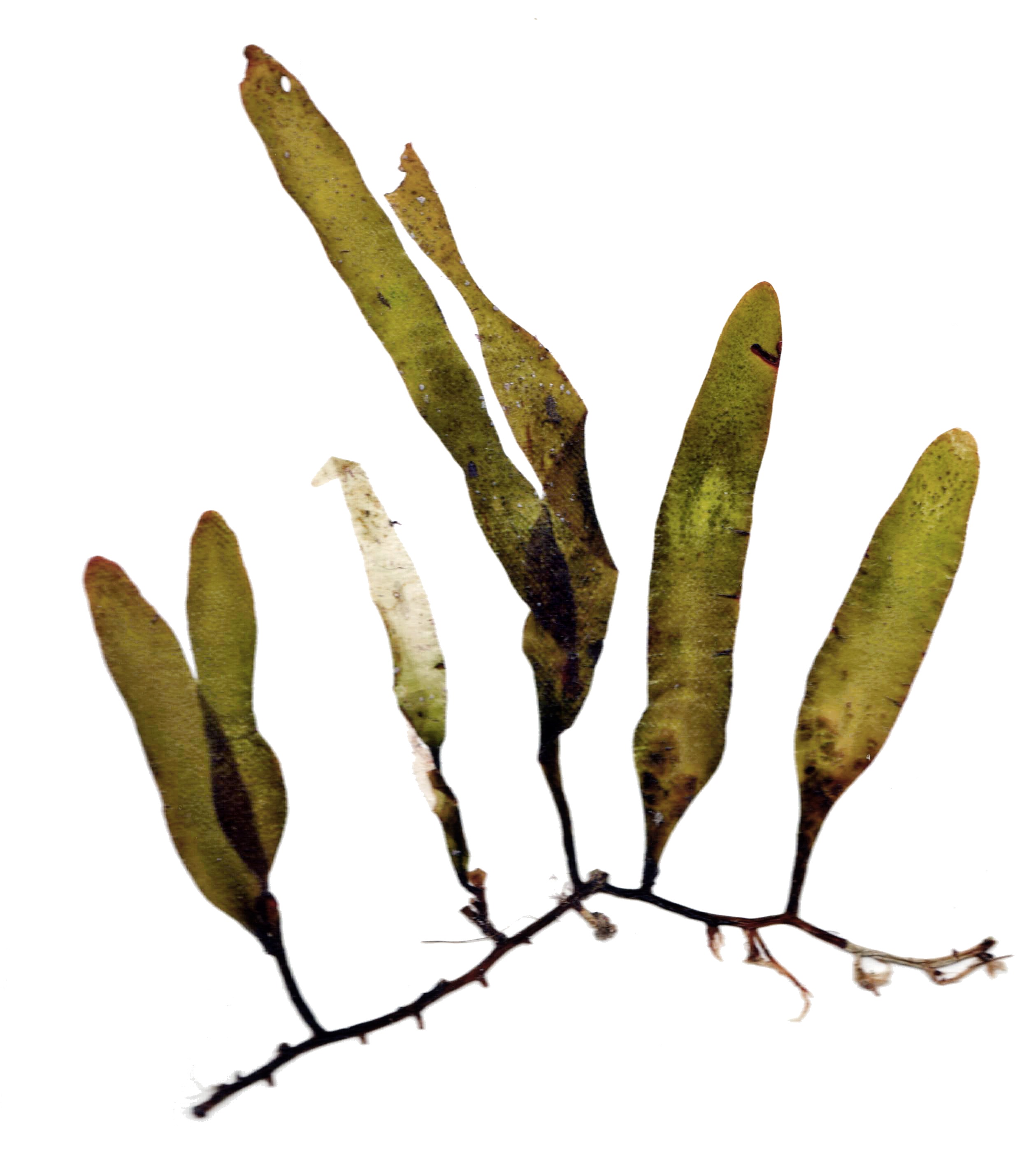Caulerpa Prolifera on:
[Wikipedia]
[Google]
[Amazon]
''Caulerpa prolifera'' is a species of green alga, a
Retrieved August 18, 2011. It grows rapidly and forms a dense mass of vegetation on shallow sandy areas of the sea.
 A plant of ''C. prolifera'' consists of a number of blades or laminae linked by underground
A plant of ''C. prolifera'' consists of a number of blades or laminae linked by underground
Retrieved August 18, 2011. Even when derived from the same source, individual plants of ''C. prolifera'' show great variability of form and it has been shown that this is in part related to the level of light. In bright locations, plants are compact, highly branched and dense, while in shady locations, populations typically have blades that are longer and thinner and can more efficiently make use of the limited light available. Two distinct forms of the alga are recognised, ''Caulerpa prolifera f. obovata'' (J.Agardh) and ''Caulerpa prolifera f. zosterifolia'' (Børgesen).
Unusual synchronous spawning by green algae (Bryopsidales), after the passage of Hurricane Wilma (2005)
Retrieved August 20, 2011.
seaweed
Seaweed, or macroalgae, refers to thousands of species of macroscopic, multicellular, marine algae. The term includes some types of '' Rhodophyta'' (red), ''Phaeophyta'' (brown) and ''Chlorophyta'' (green) macroalgae. Seaweed species such as ...
in the family Caulerpaceae. It is the type species of the genus '' Caulerpa'', the type location being Alexandria, Egypt.AlgaeBaseRetrieved August 18, 2011. It grows rapidly and forms a dense mass of vegetation on shallow sandy areas of the sea.
Description
stolon
In biology, stolons (from Latin '' stolō'', genitive ''stolōnis'' – "branch"), also known as runners, are horizontal connections between organisms. They may be part of the organism, or of its skeleton; typically, animal stolons are external s ...
s which are fixed to the sandy substrate
Substrate may refer to:
Physical layers
*Substrate (biology), the natural environment in which an organism lives, or the surface or medium on which an organism grows or is attached
** Substrate (locomotion), the surface over which an organism lo ...
by rhizoids. The blades contain chlorophyll for photosynthesis though the green colour is somewhat masked by other pigments. Like other members of the order Bryopsidales, each ''C. prolifera'' plant is an individual organism consisting of a giant single cell with multiple nuclei. Chloroplast
A chloroplast () is a type of membrane-bound organelle known as a plastid that conducts photosynthesis mostly in plant and algal cells. The photosynthetic pigment chlorophyll captures the energy from sunlight, converts it, and stores it in ...
s are free to move from one part of the organism to another as a response to the level of light at any point and there is a network of fibrous proteins that facilitates movement of organelle
In cell biology, an organelle is a specialized subunit, usually within a cell, that has a specific function. The name ''organelle'' comes from the idea that these structures are parts of cells, as organs are to the body, hence ''organelle,'' the ...
s.The Cell Biology of the BryopsidalesRetrieved August 18, 2011. Even when derived from the same source, individual plants of ''C. prolifera'' show great variability of form and it has been shown that this is in part related to the level of light. In bright locations, plants are compact, highly branched and dense, while in shady locations, populations typically have blades that are longer and thinner and can more efficiently make use of the limited light available. Two distinct forms of the alga are recognised, ''Caulerpa prolifera f. obovata'' (J.Agardh) and ''Caulerpa prolifera f. zosterifolia'' (Børgesen).
Distribution
''C. prolifera'' occurs in shallow European waters, the Mediterranean Sea and the warm eastern Atlantic Ocean and also the eastern seaboard of the United States, Mexico and Brazil, as well as certain other scattered locations.Biology
''Caulerpa spp'' help consolidate the seabed and enable seagrasses to colonize the area. ''C. prolifera'' grows rapidly with growth taking place at night at the tips of blades and stolons. At dawn, the new tips are white, but during the day chloroplasts move into the newly available space. If parts of the plant become covered in sediment, chloroplasts can be withdrawn and moved to more productive parts. Under normal conditions,asexual reproduction
Asexual reproduction is a type of reproduction that does not involve the fusion of gametes or change in the number of chromosomes. The offspring that arise by asexual reproduction from either unicellular or multicellular organisms inherit the fu ...
occurs by fragmentation of the plant. Pieces of tissue only a few millimetres across are capable of growing into new plants.
Less usually, ''C. prolifera'' may undergo sexual reproduction by holocarpy. This may occur under conditions of stress with the entire cytoplasm undergoing gametogenesis and the original organism being left as a husk. Such conditions occurred in 2005 after the passage of Hurricane Wilma over a lagoon in the Caribbean Sea. On that occasion, there was a synchronous spawning of ''C. prolifera'' and many other siphonous green algae. Besides turbulent water movement, the hurricane caused the sea temperature to drop from 29 to 19 °C in a few hours. This thermal anomaly seems to have triggered the mass spawning.Retrieved August 20, 2011.
References
External links
* {{Taxonbar, from=Q2943096 prolifera Species described in 1809